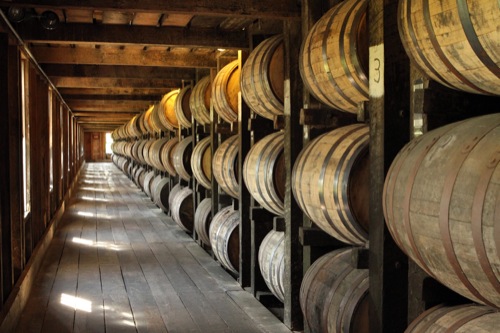
Courtesy Kentucky Bourbon Trail
Bourbon in Louisville
Although a large portion of bourbon is made in Louisville, the city doesn’t have a large distillery that offers tours. However, Michter’s Distillery is scheduled to open a small production distillery in a historic downtown building along Main Street’s Museum Row, across the street from the Louisville Slugger Museum, later this year.
Also slated to open downtown this fall is the Evan Williams Bourbon Experience in the heart of what was once called Whiskey Row. The experience will have a fully functioning artisanal pot still distillery and displays on the various aspects of bourbon production. Its signature feature will be a five-story-high, three-dimensional bourbon bottle that will appear to be pouring bourbon into a glass as part of the building facade.
The new Distilled Spirits Epicenter in Louisville has an education center for classes on bourbon-making and a small artisan distillery. The year-old facility will customize classes for groups, said marketing director Colleen Rice. “The scale is perfect for understanding,” she said.
Bourbon and Lincoln
The Oscar Getz Museum of Whiskey History in a 194-year-old Federal-style building in Bardstown has a large collection of b ottles, stills, marketing signs and other items covering the history of whiskey from pre-Colonial times to the present.
One of the items is a photocopy of a handwritten license from the state of Illinois to Lincoln and William Berry, with their signatures at the bottom, to sell liquor in their store in New Salem.
The license makes a nice segue connecting two of the region’s most famous draws. At the Abraham Lincoln Birthplace National Historic Site near Hodgenville, less than 30 miles from Bardstown, a stately granite and marble neoclassical memorial houses a small log cabin representative of the type in which Lincoln was born at the site.
“Even though it is not the original, it is symbolic of where he got his humble beginnings,” said national park ranger Patti Reynolds. “It was the first memorial built to Lincoln. It was built before the Lincoln Memorial.”
President Theodore Roosevelt laid the cornerstone for the memorial in 1909, and President William Howard Taft dedicated the memorial two years later.
“We focus on the first seven years he spent here,” said Stacy Humphreys, chief of interpretation. “That is our primary focus.”
The most prized Lincoln artifact there is the family Bible, printed in 1799, which contains the handwritten notice of Lincoln’s birth on February 12, 1809.
New Lincoln Museum
The new Lincoln Legacy Museum in the renovated former 1816 courthouse in Springfield looks at Lincoln’s entire life.
“We felt it was best to tell the whole Lincoln story, although Washington County was just a small part,” said Washington County judge/executive John Settles.
The museum, which will be dedicated April 12, has 12 large cabinets with panels of text and photos on the front and back telling the story of Lincoln’s life. One of the most important items is a copy of the marriage license of Lincoln’s parents, Thomas Lincoln and Nancy Hanks.
“His parents were married here,” said Settles. “We have the original documents to verify they were married.”
A copy of the marriage bond and license are also inscribed on a statue of Lincoln across the street in front of the county’s new judicial center, which replaced the courthouse.
In Hodgenville, the Lincoln Museum has a dozen dioramas that also cover his life. They range from the cabin years in Kentucky through the Lincoln-Douglas debates, his second inauguration and his assassination at Ford’s Theatre.
In August 1841, a depressed Lincoln spent three and a half weeks at the Farmington plantation in Louisville with his friend Joshua Speed after Lincoln broke off his first engagement to Mary Todd.
The Federal-style house, whose symmetrical design was inspired by Thomas Jefferson, is preserved on 18 acres in a busy suburban area of Louisville. Its 14 rooms are authentic period furnishings to 1841, with some pieces that belonged to the Speed family.
“It appears today as it appeared in 1841 when Lincoln came here,” said Terry Lynn Pyles, a docent at the house.
The Speeds had nearly 60 slaves and assigned one to Lincoln for his personal needs. “Several historians say his time here was critical to his understanding of slavery,” said Pyles. “It gave him a real insight into slavery.”











